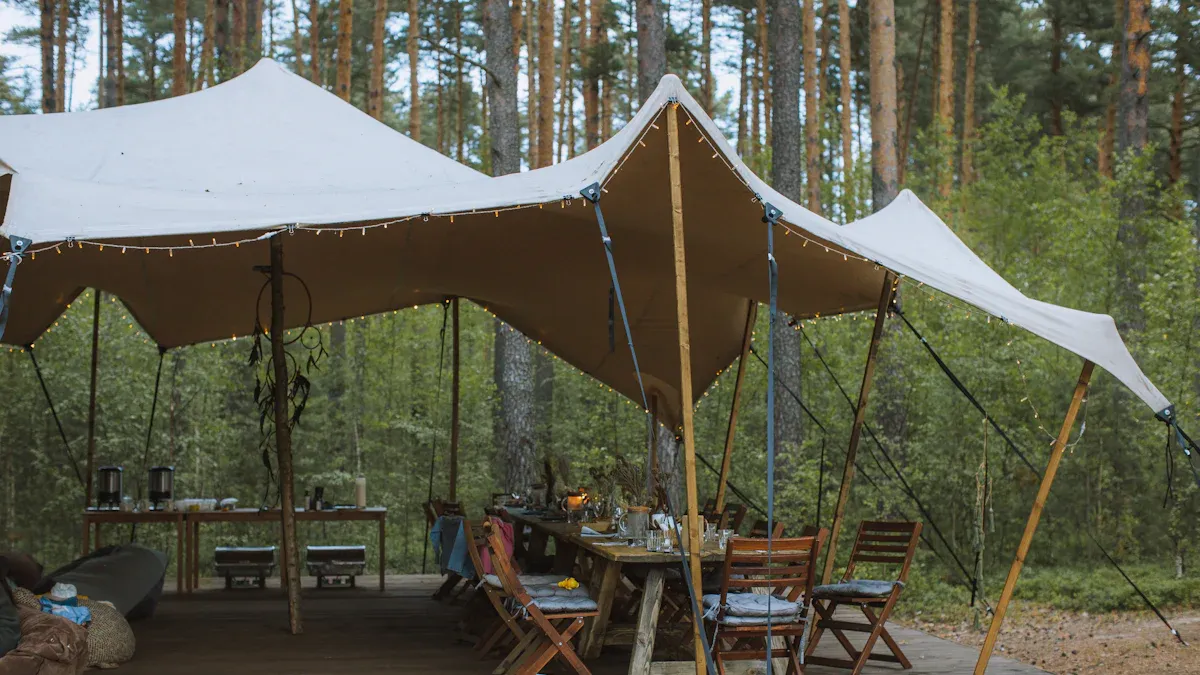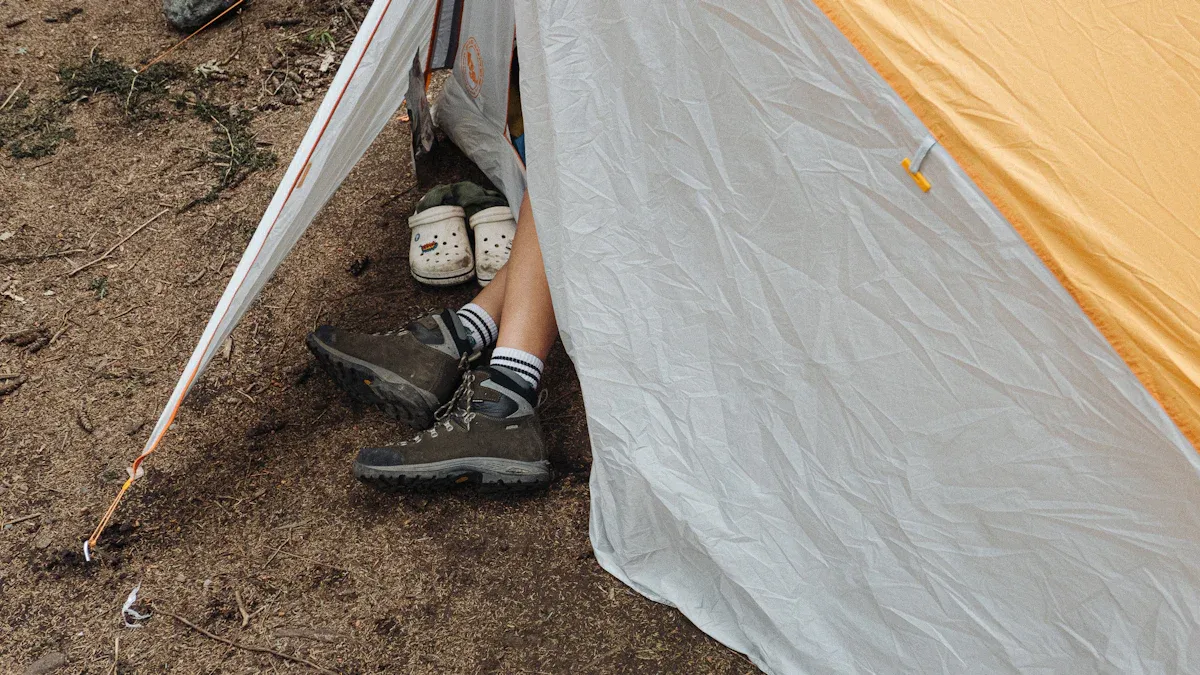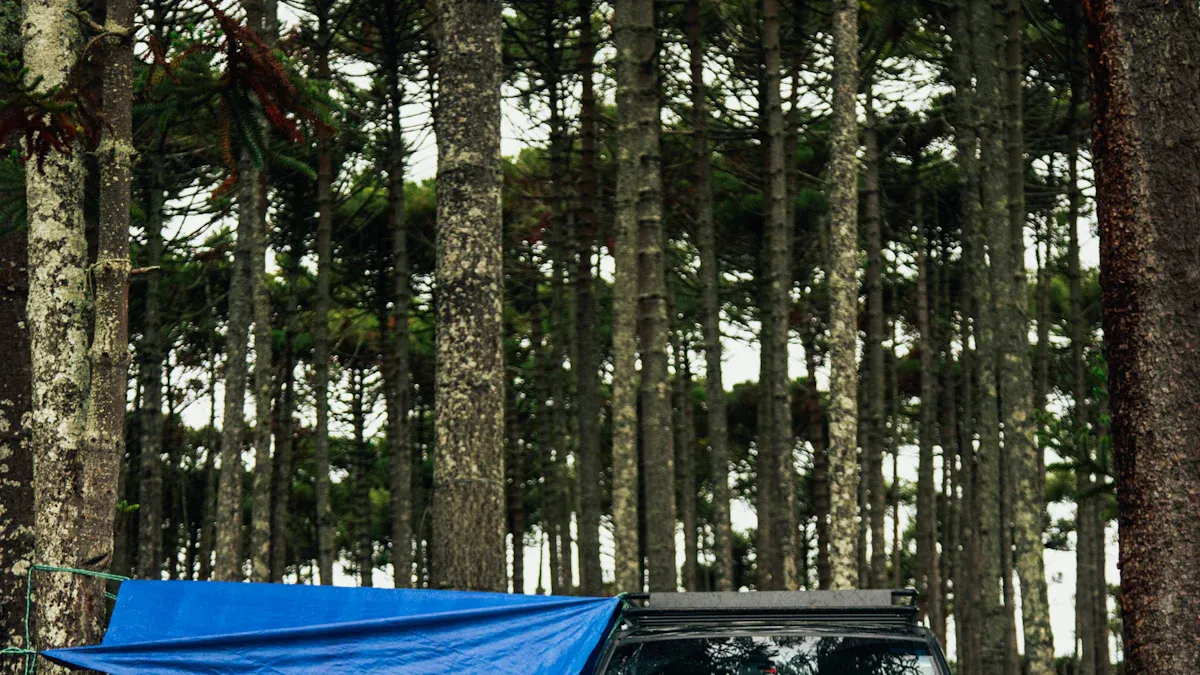
If you want to know how to hang tarp for shade, start by picking strong trees or poles. This step matters most for safety. You can do it even if you have never tried before. Just follow each step and you will create a cool, shady spot in no time!
Key Takeaways
Choose strong trees or poles for hanging your tarp. This ensures safety and stability.
Use the right materials like nylon or vinyl-laminated polyester for durability and protection from the elements.
Adjust the height of your tarp to prevent water pooling and maximize shade throughout the day.
Materials and Tools

Materials
When you want to know how to hang tarp for shade, start with the right materials. Not all tarps work the same way. Some last longer and give better protection. Here are some of the best choices:
Nylon: This material feels light but holds up well. It stretches a bit, so it can handle wind and movement.
Vinyl-laminated polyester: You get fire resistance and waterproofing. It works well for long-term setups.
Canvas and Vinyl: These tarps resist scratches and rough use. They work great in tough weather.
Knitted polyethylene mesh: This lets air flow through while blocking the sun. It keeps your shaded area cool.
You can also look at popular brands like Aqua Quest Safari, Aqua Quest Defender, and CCS Tundra. These brands offer strong, lightweight tarps that outdoor experts trust.
Tip: Canvas tarps last 1-5 years, polyethylene tarps last 3-7 years, and PVC tarps can last up to 10 years outside.
Tools
You need a few tools to set up your tarp safely and securely:
Rope or paracord
Bungee cords and hooks
Toggle, snap, or twist lock fasteners
These tools help you tie down your tarp and keep it steady, even if the wind picks up.
Extras
Some extras can make your shade setup even better. Check out the table below for ideas:
Consideration |
Description |
|---|---|
Stainless steel parts last longer and resist rust. |
|
Compatibility |
Make sure your kit fits your tarp size and shape. |
Complete set |
Look for kits with all the parts you need. |
Easy adjustment |
Choose fasteners that let you tighten or loosen the tarp easily. |
Brand reputation |
Pick brands with good reviews and clear instructions. |
You can also add side walls for more privacy and protection from the wind or rain. Modular designs let you use one or more walls as needed.
How to Hang Tarp for Shade: Steps

Choose Location
Picking the right spot is the first step in how to hang tarp for shade. You want a place that gives you the most shade and keeps your tarp safe. Here are some things to think about:
Look at where the sun moves during the day. Try to set up your tarp so it blocks the strongest sunlight, especially in the afternoon.
Check the wind. If the area gets strong winds, make sure your tarp will not blow away or tear.
Find strong anchor points like healthy trees, sturdy poles, or solid posts. Weak spots can cause your tarp to fall.
Think about the height. Hanging your tarp at an angle helps rain and leaves slide off instead of pooling on top.
Remember, tarps and shade sails are not always perfect shapes. You may need to adjust your setup to fit the space.
Tip: If you want shade all day, try to face your tarp east-west. This way, you block the sun as it moves.
Set Rope
Now you need to set up the ropes that will hold your tarp. This step is key in how to hang tarp for shade because it keeps everything stable.
Find two strong trees or poles. Tie a main rope (called a ridgeline) between them. Make it as high as you can so people can walk under the tarp.
Use a knot that holds tight but is easy to untie, like a trucker's hitch or bowline.
Lay your tarp over the ridgeline. Center it so it covers the area you want to shade.
Tie ropes to each corner of the tarp. These are your guy lines.
Safety Note: Always check that your ropes and knots are secure before moving on. Loose ropes can cause the tarp to fall.
Lay Tarp
Once your ropes are ready, you can lay out your tarp. Spread it flat over the ridgeline. Make sure the tarp covers the area you want to shade. If you see wrinkles or folds, smooth them out. Wrinkles can cause water to pool or the tarp to flap in the wind.
Tip |
Description |
|---|---|
Measure Properly |
Leave an extra 2–4 inches on all sides so the grommets sit off the edge. This helps keep the tarp tight. |
Use Bungee Cords |
Bungee cords let the tarp move a little in the wind, which stops it from tearing. |
Note: Dry your tarp flat after use to keep it in good shape.
Tie Down
Tying down your tarp is a big part of how to hang tarp for shade. You want it tight, but not so tight that it rips.
Use all the grommets along the edge of your tarp. This spreads out the force and keeps the tarp from tearing.
If your tarp does not have enough grommets, add more with a grommet kit or use tarp clips.
Use knots like the taut-line hitch or Siberian hitch for easy adjustments.
Attach the guy lines to ground stakes. Angle the lines toward the center of the tarp for the best hold.
Use bungee cords instead of only rope. Bungees stretch and help the tarp move with the wind.
Safety Tip: Always check that your stakes are deep enough and will not pull out if the wind picks up.
Anchor Corners
Anchoring the corners keeps your tarp from flapping or tearing. Here are some ways to do it:
Use sandbags or water tubes as weights. Place them every 3 to 4 feet along the edge.
Wrap the tarp edge around a 2×4 wood batten and secure it to a deck or solid surface.
Use rope tie-downs, but avoid tying to gutters or weak spots.
For soft ground, use stakes like Y stakes or V stakes. For sand or snow, use wide stakes made for those surfaces.
Try running a cord through three grommets at each corner. Tie the ends to the outside grommets and clip a carabiner to the middle. This spreads out the force and keeps the grommets from tearing.
Stake Type |
Best For |
Notes |
|---|---|---|
Peg or needle |
Medium compact soil |
Easy to pound in, less holding power. Good for hard ground. |
Shepard’s hook |
General use |
Long and thin, pound in deep. Can bend if not careful. |
Most conditions |
Strong and holds well, but hard to use in rocky ground. |
|
V stake |
Soft to medium soil |
Good hold, may bend in hard ground. |
Snow or sand stake |
Soft substrates |
Wide and heavy, best for sand or snow. |
Adjust Height
Adjusting the height of your tarp helps you get the best shade and stops water from pooling. Raise one side higher than the other to make a slope. This lets rain run off and keeps leaves from piling up.
Use sticks or poles under the corners if you need more height.
Make sure the lowest side faces the direction where water will drain away from your sitting area.
If you want more shade as the sun moves, try a wing or lean-to setup. These let you change the angle during the day.
Tip: A lean-to shape works great for blocking midday sun. A wing shape lets you adjust as the sun moves.
Check Stability
The last step in how to hang tarp for shade is checking that everything is safe and stable.
Walk around and look for loose ropes, sagging spots, or flapping edges.
Tighten any lines that look loose. Use knots that let you adjust tension easily.
Make sure the tarp is not rubbing against sharp objects. This can cause rips.
Inspect the tarp for small tears or holes. Fix them right away to stop bigger problems.
Clean your tarp every few months and check all the hardware at least twice a year.
Regular checks help your tarp last longer and keep your shade safe.
If you follow these steps, you will know how to hang tarp for shade in a way that keeps you cool and comfortable. You will also protect your tarp from damage and make it last for many seasons.
You now know how to hang tarp for shade and create a cool spot outside. Mesh tarps work well because they block UV rays and let air flow, saving you money over time. When you finish, store your tarp right to make it last:
Clean and dry the tarp before folding.
Keep it off the ground in a dry, cool place.
Try these steps and enjoy your new shade! Got tips or questions? Drop them in the comments below.
FAQ
How do you keep your tarp from sagging?
You can tighten the guy lines and adjust the height. Try using bungee cords for extra tension. Check the tarp often for loose spots.
Tip: Always pull the tarp tight before you secure the corners.
What is the best knot for tying down a tarp?
You should use a taut-line hitch or a bowline knot. Both knots hold strong and let you adjust the tension easily.
Knot Name |
Use Case |
|---|---|
Taut-line hitch |
Adjustable lines |
Bowline |
Secure corners |
Can you hang a tarp without trees or poles?
Yes, you can use sturdy stakes, fence posts, or even your car roof rack. Make sure each anchor point can hold the tarp tight.

